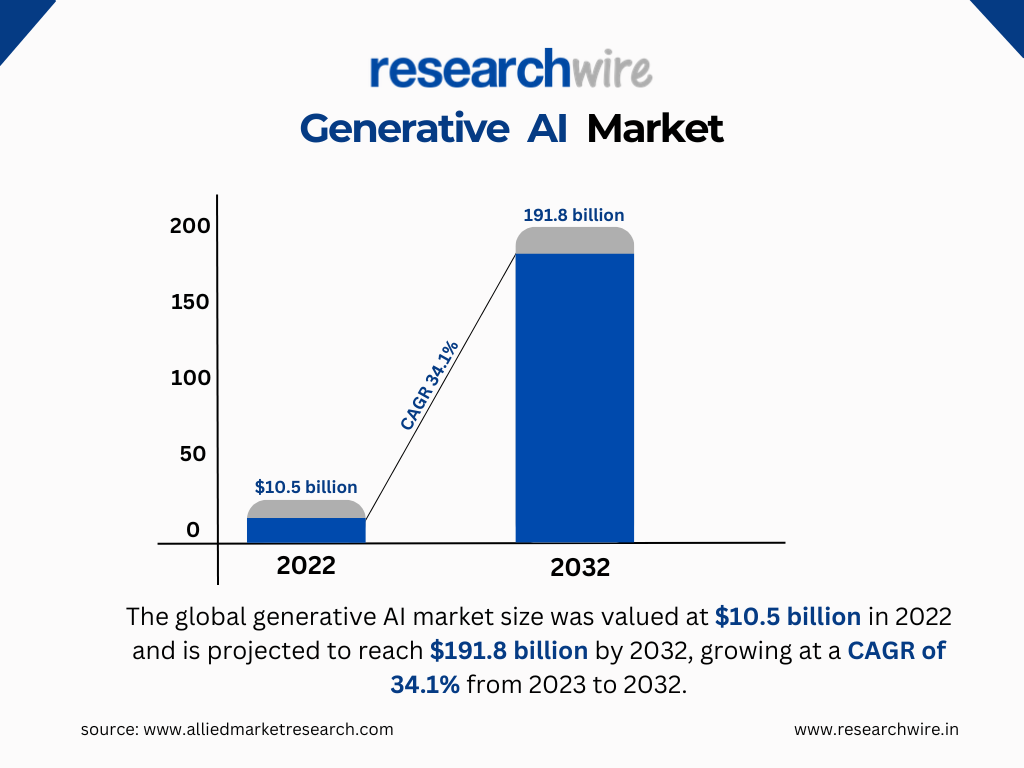Generative AI has its roots in the field of artificial intelligence, tracing back to the concept of generative models. These models aim to capture the underlying structure of a given dataset and generate new data instances from that same distribution. The evolution of generative AI has been marked by significant advancements in deep learning techniques, particularly in the domain of neural networks. In the 1980s, the field saw significant developments with the introduction of Boltzmann machines and restricted Boltzmann machines (RBMs), which laid the groundwork for modern generative AI techniques.
However, it wasn’t until the mid-2010s that generative AI truly began to gain traction, thanks to breakthroughs in deep learning. One pivotal advancement was the introduction of Generative Adversarial Networks (GANs) by Ian Goodfellow and his colleagues in 2014. GANs revolutionized the field by pitting two neural networks against each other – a generator and a discriminator – to produce realistic synthetic data.
Overview of Generative AI Technologies:
Generative AI encompasses a wide range of technologies and approaches, all aimed at generating new content or data samples. Apart from GANs, other notable techniques include Variational Autoencoders (VAEs), Autoregressive Models, and Generative Pre-trained Transformer (GPT) models.
-
Variational Autoencoders (VAEs):
VAEs are probabilistic models that learn to encode and decode data. They are commonly used for tasks such as image generation and data compression.
-
Autoregressive Models:
Autoregressive models generate data sequentially, one element at a time, based on a probability distribution conditioned on previous elements. Examples include PixelCNN and WaveNet.
-
Generative Pre-trained Transformer (GPT) models:
GPT models utilize transformer architectures and large-scale pre-training on text data to generate coherent and contextually relevant text. These models have found applications in natural language processing, chatbots, and content generation.
Generative AI technologies continue to evolve rapidly, driving innovation across various domains, including art, media, healthcare, and finance.
-
Industry-wide Applications:
Generative AI technologies have found applications across a wide range of industries, revolutionizing traditional processes and enabling innovative solutions.
In the entertainment industry, generative AI is being used for content creation, such as generating realistic images, videos, and music. This technology allows artists and content creators to explore new creative avenues and produce engaging multimedia content.
In the healthcare sector, generative AI is being utilized for medical image generation, drug discovery, and personalized medicine. For example, researchers are using generative models to generate synthetic medical images for training and testing diagnostic algorithms, leading to more accurate and efficient medical imaging systems.
The retail and e-commerce industry are leveraging generative AI for product recommendation systems, virtual try-on experiences, and personalized marketing campaigns. By analysing customer data and generating personalized recommendations, retailers can enhance the shopping experience and increase customer engagement and sales.
Additionally, in the gaming industry, generative AI is being used for procedural content generation, character animation, and level design. This technology enables game developers to create dynamic and immersive gaming experiences with endless possibilities for exploration and discovery.
-
Exemplary Use Cases for End Users:
One exemplary use case of generative AI for end users is in the field of digital art. Artists and designers are using generative models to create stunning visual artworks, interactive installations, and immersive experiences. By harnessing the power of generative AI, artists can explore new creative techniques and push the boundaries of traditional art forms.
Another notable use case is in natural language processing applications, such as chatbots and virtual assistants. Generative AI models like OpenAI’s GPT series can generate human-like text based on input prompts, enabling more natural and engaging interactions between users and AI systems. This technology has applications in customer service, education, and entertainment, among others.
Leading Companies and Prominent Players
Several companies and research institutions are at the forefront of advancing generative AI technologies and driving innovation in the field.
OpenAI is one of the leading organizations pioneering research in generative AI, with its groundbreaking work on GANs and language models like GPT. Their research has led to significant advancements in natural language understanding, image synthesis, and reinforcement learning.
NVIDIA, a prominent player in the AI hardware space, has also made significant contributions to generative AI with its development of high-performance GPUs optimized for deep learning tasks. Their hardware accelerators enable researchers and developers to train and deploy complex generative models at scale, powering applications in computer vision, robotics, and autonomous vehicles.
Other key players in the generative AI landscape include Google Brain, Facebook AI Research (FAIR), Microsoft Research, and various academic institutions and startups around the world. These organizations are pushing the boundaries of what’s possible with generative AI and driving innovation across diverse domains, from healthcare and finance to art and entertainment.
Market Insights and Trends

- Current Landscape of Generative AI Market:
The market for generative AI is experiencing rapid growth and expansion, driven by increasing demand for AI-driven solutions across various industries. Generative AI technologies are being adopted by organizations worldwide to enhance creativity, improve productivity, and drive innovation.
In recent years, the market has witnessed significant advancements in generative AI models, algorithms, and applications. From image synthesis and text generation to music composition and video editing, generative AI is transforming how businesses operate and interact with their customers.
According to a recently published research report by Allied Research Report, the global generative AI market size was valued at $10.5 billion in 2022 and is projected to reach $191.8 billion by 2032, growing at a CAGR of 34.1% from 2023 to 2032.
-
Future Trends:
The future of the generative AI market looks promising, with analysts projecting continued growth and adoption of these technologies.
Factors driving this growth include advancements in deep learning algorithms, increasing availability of data and computing resources, and growing demand for AI-powered creative tools and applications. Industries such as healthcare, media and entertainment, retail, and finance are expected to be key drivers of market growth, leveraging generative AI to unlock new opportunities and address complex challenges.
Challenges and Regulatory Landscape
-
Downsides and Risks of Generative AI:
While generative AI offers numerous benefits, including enhanced creativity, productivity, and innovation, it also poses certain challenges and risks. One of the primary concerns is the potential for misuse of generative AI technologies, such as deepfake videos and fake news generation, which can have serious consequences for individuals, businesses, and society.
Other risks associated with generative AI include ethical considerations, such as bias and fairness in algorithmic decision-making, as well as privacy concerns related to the generation of synthetic data. Additionally, there are technical challenges, such as model robustness and interpretability, that need to be addressed to ensure the reliability and trustworthiness of generative AI systems.
-
Legal Regulations and Intellectual Property Rights:
The rapid advancement of generative AI technologies has prompted policymakers to consider new regulations and frameworks to address legal and ethical issues. Intellectual property rights are a key area of concern, as generative AI raises questions about ownership and authorship of generated content.
Companies and individuals working with generative AI technologies need to navigate a complex legal landscape to protect their intellectual property rights and ensure compliance with relevant regulations. This includes securing patents for novel inventions, copyrights for creative works, and trademarks for branding and identity protection.
Utilizing Researchwire for Generative AI Solutions
-
Leveraging State-of-the-Art Insights for Product/Service Development:
Researchwire offers valuable insights and resources for companies looking to develop products or services based on generative AI. By leveraging cutting-edge research and expertise in the field, Researchwire provides companies with the latest developments, trends, and best practices in generative AI, helping them stay ahead of the competition and deliver innovative solutions to their customers.
Building Patent Portfolios with Researchwire
-
Strategies for Optimal Protection and ROI in Generative AI Patents:
Researchwire assists companies in building patent portfolios pertaining to generative AI, ensuring optimal protection of their intellectual property assets. By conducting comprehensive patent analysis and strategic guidance, Researchwire helps companies identify valuable patents, file patent applications, and navigate the patent prosecution process to maximize return on investment (ROI).
Overall, Researchwire plays a crucial role in helping companies navigate the complex landscape of generative AI, from developing innovative solutions to protecting intellectual property rights and ensuring compliance with legal and regulatory requirements. By leveraging Researchwire’s expertise and resources, companies can unlock the full potential of generative AI and drive sustainable growth and innovation.
In addition to patent portfolio management, Researchwire assists companies in leveraging their generative AI-based patents for commercialization or transaction activities. Whether it’s licensing agreements, partnerships, or mergers and acquisitions, Researchwire provides valuable insights and support throughout the process.
Defending Against Infringement Lawsuits with Researchwire
In the event of infringement lawsuits, Researchwire also aids companies by challenging the validity of patents before appropriate avenues. Through thorough analysis and expert testimony, Researchwire helps companies mount a strong defence and protect their interests in legal proceedings related to generative AI patents.
Generative AI represents a transformative technology with vast potential across various industries. However, navigating the complex landscape of intellectual property rights and legal regulations requires expertise and strategic guidance. With Researchwire’s support, companies can unlock the full potential of generative AI while safeguarding their innovations and maximizing returns on investment.
Conclusion
Generative AI stands at the forefront of technological innovation, offering a glimpse into a future where artificial intelligence not only understands data but creates it. This technology’s journey traces back to the inception of generative models, where it aimed to capture the essence of data distribution. Over time, fueled by breakthroughs in deep learning, especially through advancements like Generative Adversarial Networks (GANs), the field has burgeoned, pushing the boundaries of creativity and imagination.
Today, generative AI finds application across diverse sectors. In entertainment, it fuels content creation; in healthcare, it revolutionizes diagnostics and drug discovery. Retail and e-commerce leverage it for personalized marketing, while gaming benefits from procedural content generation. Such broad industry applications underscore the versatility and potential of generative AI.
Yet, with innovation come challenges. Concerns about misuse, ethical dilemmas, and legal regulations loom large. Intellectual property rights pose complex questions about ownership and regulation.
However, with Researchwire, companies can navigate these challenges with confidence. From providing cutting-edge insights for product development to building robust patent portfolios and defending against infringement lawsuits, Researchwire empowers companies to harness the full potential of generative AI while safeguarding their innovations.
As generative AI continues to evolve and shape the future, Researchwire stands as a reliable partner, guiding companies towards success in the dynamic landscape of intellectual property rights and technological innovation.
About Us
Researchwire is an ISO 27001 certified, specialised IP research and R&D support company. Works closely with IP & legal teams to provide patent portfolio services and all types of patent searches & patent drafting. It provides enterprises and R&D centres with insightful and effective solutions to address their technology development challenges and roadmap planning.



